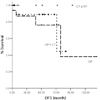1. Townsend CM, Beauchamp RD, Evers BM, Mattox KL. Sabiston Textbook of Surgery: the biological basis of modern surgical practice. 2004. 17th ed. Philadelphia: W.B. Saunders.
2. Halme L, Mecklin JP, Juhola M, Krees R, Palmu A. Primary gastrointestinal non-Hodgkin's lymphoma. A population based study in central Finland in 1975-1993. Acta Oncol. 1997. 36:69–74.

3. Hahn JS, Lee S, Chong SY, Min YH, Ko YW. Eight-year experience of malignant lymphoma-survival and prognostic factors. Yonsei Med J. 1997. 38:270–284.

4. Bertoni F, Zucca E. State-of-the-art therapeutics: marginal-zone lymphoma. J Clin Oncol. 2005. 23:6415–6420.

5. Lewin KJ, Ranchod M, Dorfman RF. Lymphomas of the gastrointestinal tract: a study of 117 cases presenting with gastrointestinal disease. Cancer. 1978. 42:693–707.

6. Brands F, Mönig SP, Raab M. Treatment and prognosis of gastric lymphoma. Eur J Surg. 1997. 163:803–813.
7. Kodera Y, Yamamura Y, Nakamura S, Shimizu Y, Torii A, Hirai T, et al. The role of radical gastrectomy with systematic lymphadenectomy for the diagnosis and treatment of primary gastric lymphoma. Ann Surg. 1998. 227:45–50.

8. Maor MH, Maddux B, Osborne BM, Fuller LM, Sullivan JA, Nelson RS, et al. Stage IE and IIE non-Hodgkin's lymphomas of the stomach. Comparison of treatment modalities. Cancer. 1984. 54:2330–2337.

9. Avilés A, Diaz-Maqueo JC, De la Torre A, Rodriguez L, Guzmán R, Talavera A, et al. Is surgery necessary in the treatment of primary gastric non-Hodgkin lymphoma? Leuk Lymphom. 1991. 5:365–369.

10. Liu HT, Hsu C, Chen CL, Chiang IP, Chen LT, Chen YC, et al. Chemotherapy alone versus surgery followed by chemotherapy for stage I/IIE large-cell lymphoma of the stomach. Am J Hematol. 2000. 64:175–179.

11. Avilés A, Nambo MJ, Neri N, Huerta-Guzmán J, Cuadra I, Alvarado I, et al. The role of surgery in primary gastric lymphoma: results of a controlled clinical trial. Ann Surg. 2004. 240:44–50.
12. Kang YK, Chang HM, Ryoo BY, Song HS, Eo WK, Ryu MH. Comparison of surgery + chemotherapy ± radiation with chemotherapy ± radiation for localized aggressive B-cell primary gastric lymphomas. 2002. Seoul: The 28th Annual Meeting of the Korean Cancer Association;127. (Abstr. 129).
13. Ferreri AJ, Cordio S, Paro S, Ponzoni M, Freschi M, Veglia F, et al. Therapeutic management of stage I-II high-grade primary gastric lymphomas. Oncology. 1999. 56:274–282.

14. Koch P, Probst A, Berdel WE, Willich NA, Reinartz G, Brockmann J, et al. Treatment results in localized primary gastric lymphoma: data of patients registered within the German multicenter study (GIT NHL 02/96). J Clin Oncol. 2005. 23:7050–7059.

15. Gobbi PG, Dionigi P, Barbieri F, Corbella F, Bertoloni D, Grignani G, et al. The role of surgery in the multimodal treatment of primary gastric non-Hodgkin's lymphomas. A report of 76 cases and review of literature. Cancer. 1990. 65:2528–2536.

16. Oh DY, Choi IS, Kim JH, Rhu MH, Kim TY, Heo DS, et al. Management of gastric lymphoma with chemotherapy alone. Leuk Lymphoma. 2005. 46:1329–1335.

17. Ishikura S, Tobinai K, Ohtsu A, Nakamura S, Yoshino T, Oda I, et al. Japanese multicenter phase II study of CHOP followed by radiotherapy in stage I-II1, diffuse large B-cell lymphoma of the stomach. Cancer Sci. 2005. 96:349–352.

18. Antony AC. Hoffman R, Benz EJ, Shattil SJ, Furie B, Cohen HJ, Silberstein LE, editors. Megaloblastic aemia. Hematology. Basic Principles and Practice. 2005. 4th ed. Philadelphia: Churchill Livingstone;519–550.
19. Ko YW, Min JS, Suh HC, Cho JS, Lee S, Chong SY, et al. Vitamin B12 deficiency anemia after total gastrectomy in patients with stomach cancer. Korean J Intern Med. 1998. 54:386–396.
20. Hines JD, Hoffbrand AV, Mollin DL. The hematologic complications following partial gastrectomy: A study of 292 patients. Am J Med. 1967. 43:555–569.
21. Mahmud K, Ripley D, Swaim WR, Doscherholmen A. Hematologic complications of partial gastrectomy. Ann Surg. 1973. 177:432–435.






 PDF
PDF ePub
ePub Citation
Citation Print
Print







 XML Download
XML Download